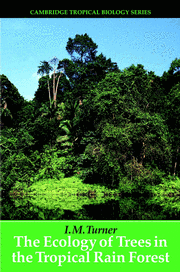6 - Classificatory systems for tropical trees
Published online by Cambridge University Press: 24 November 2009
Summary
Height at maturity
Forest ecologists have generally understated the rather obvious distinction between species in their height at reproductive maturity. Species are often divided into height classes in ecological analyses, but it seems more with the purpose of comparing like with like within the stature groups, than of making comparisons among the groups. However, some general trends do emerge from the literature, and these are summarised in Table 6.1 as a series of characteristics of small-statured species in comparison to those of larger size at maturity.
The factor that appears to determine mature height is the size at onset of reproduction. Small-statured tree species start reproduction at smaller size (Thomas 1996b; Davies & Ashton 1999). Thomas (1996b) found this both in absolute terms and in size relative to asymptotic height. Allocation to reproduction probably requires a compromise in height growth rate, and hence these trees are left behind in the height growth race by the taller-growing species. Thomas (1996b) found that the change in the slope of the H–D regression from linear to asymptotic for a species generally coincided with the onset of reproduction.
Reproduction at small size need not necessarily imply reproduction at an earlier age. A very shade-tolerant understorey tree may grow very slowly and so be as old as, if not older than, a canopy tree that grew up in a gap. However, it is likely that on average small-statured trees do reproduce earlier in life than large-statured ones.
- Type
- Chapter
- Information
- The Ecology of Trees in the Tropical Rain Forest , pp. 227 - 247Publisher: Cambridge University PressPrint publication year: 2001
- 1
- Cited by



